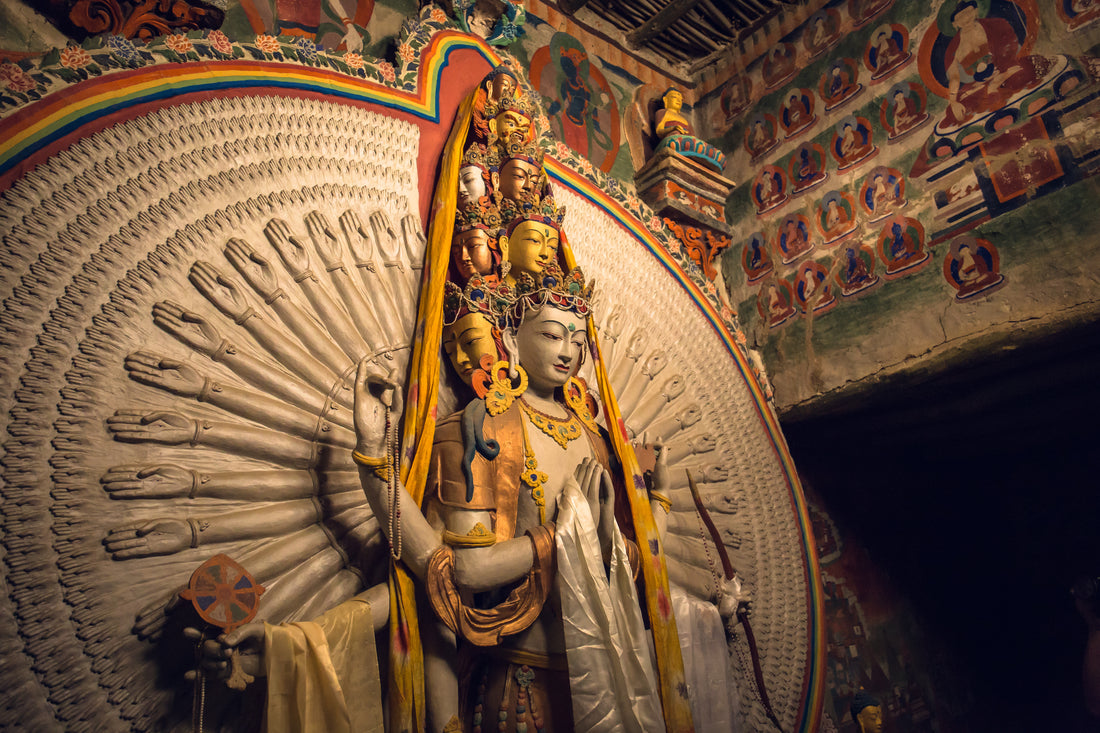In Buddhism, Avalokiteshvara, or Chenrezig, is known as the bodhisattva of compassion. A bodhisattva is a being who has completed their journey towards enlightenment, but postpones entering nirvana in order to help others along their path to enlightenment first.

Bodhisattva Avalokiteshvara is a deity with many forms and names depending on which of the various regions and cultures across Asia he is mentioned in. In Chinese Buddhism, he is synonymous with the goddess Kuan Yin (also known as Guan Yin, Quan Yin, or Guanshiyin), his female form. Bodhisattvas are considered genderless therefore allowing them to manifest into a multitude of forms, as well as bare female and/ or male characteristics freely. One of Avalokiteshvara’s most iconic artistic depictions is that of thousand armed Avalokiteshvara; with one thousand arms and/ or eyes surrounding him like a fan, he is ready and able to see and help all those in need. He is also commonly portrayed as adorned with opulent robes and jewels to attest to his grand status as a deity, and to convey his presence in the material realm.

His story is believed to have reached its full sphere of influence across Asia around the 6th century CE. As with many bodhisattvas, his origin story is complex and varied depending on the different belief systems within Buddhism. One of his most accepted backstories is that he came from Amitabha (Amitayus) Buddha to be his assistant on earth helping those in need, with some of his earliest mentions being in the Lotus Sutra (Buddhist scripture) between the 1st and 3rd centuries CE.
Although his exact point of origin may have been lost to history over the centuries, he is undoubtedly recognized for his role in another bodhisattva’s creation- the goddess of mercy, Tārā. According to the story, while on his mission to save all beings Avalokiteshvara witnessed their great suffering, so, in an outburst of deep compassion, he cried a lake of tears and from that lake sprouted a lotus. When the lotus blossomed it revealed the goddess Tara, who then pledged to aid Avalokiteshvara in his pursuit of mercy for all beings.
Today, Avalokiteshvara’s significance is that he reminds us to remain compassionate and patient toward those around us. His presence brings comfort to those on the path of enlightenment as he protects them along their journey. His great sacrifice of delaying his own entrance into buddhahood for the sake of helping other earthly beings first is his most valuable lesson, and should inspire us to seek the more selfless path from time to time in our own mortal lives.



3 comments
OM Mane Padma Hum✨
Gregory Penderghest, thank you, I can actually hear the suffering giving rise to your observations and comment. I invite you to reconsider your understanding and relationship to “metaphor“ in spiritual practice. When we move beyond a conceptual relationship to metaphor, we begin to experience something new in ourselves beyond the evidence adduced by reason. That “new something“ is neither an avoidance of the facts you noted, nor hopeful-but-passive acquiescence. It is actually the effects of the crucible-shattering resulting from Avalokiteshvara’s vow to do the impossible, namely to end the suffering of others, which results in a transformation in oneself. Thank you for the energy giving expression to your reply.
With all those eyes, he/she cannot see the pervasive misery in the world? War, greed, poverty, starvation, desecration of the planet, etc. And yet they do nothing. Just like every other deity in every other religion, they may have acted historically, but they are nowhere to be found, except, possibly metaphorically. Too bad Metaphors won’t feed, pacify, help any one. What did Bodhidharma say about the goal of Buddhism? – “Vast emptiness and nothing sacred.” Not so very subtle teaching. If the teaching on Karma were touch more widely and were immediately demonstrable, a lot of the mess in the world would clear up. If they were truly tuned into the needs of the world, they would act without waiting to be summoned. A parent acts in the best interest of their child without needing a request or approbation. Other wise this teaching, to paraphrase Marx (I think is was) further typifies his saying that religion is the opiate of the masses.